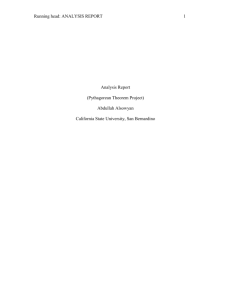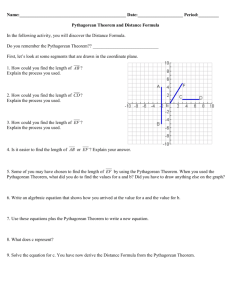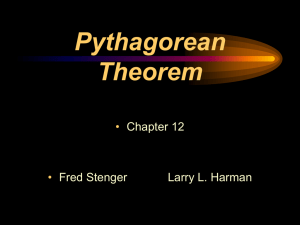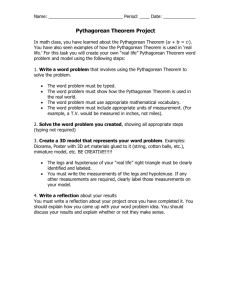Introduction Task Process Resources Evaluation Conclusion Credits
advertisement
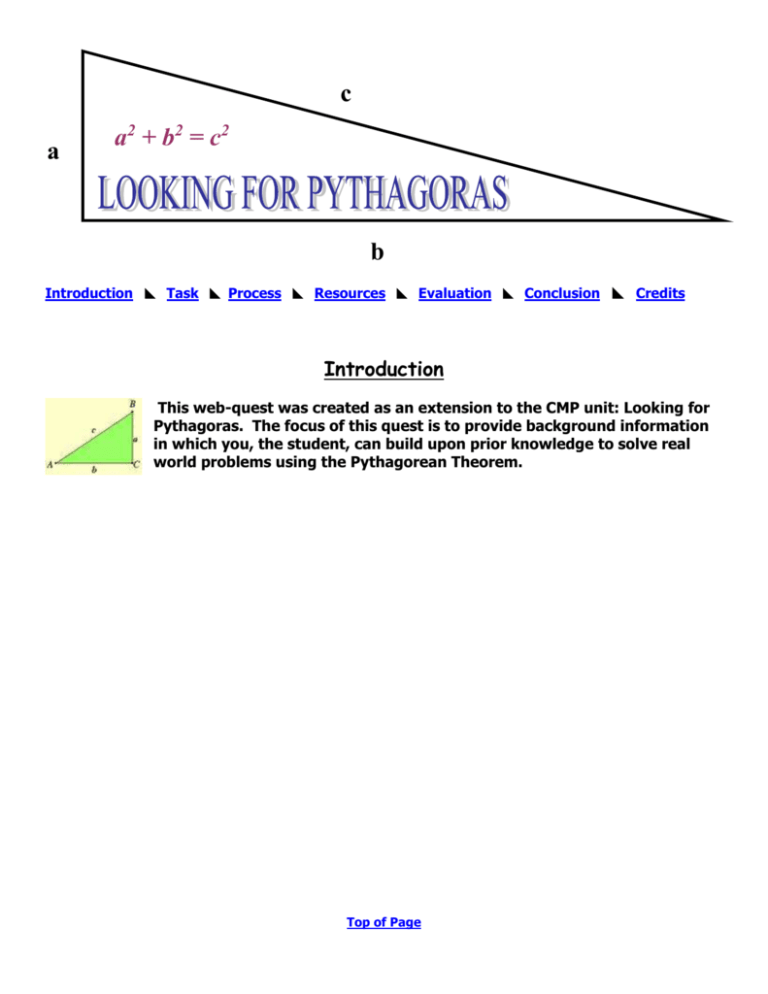
c a a2 + b2 = c2 b Introduction Task Process Resources Evaluation Conclusion Credits Introduction This web-quest was created as an extension to the CMP unit: Looking for Pythagoras. The focus of this quest is to provide background information in which you, the student, can build upon prior knowledge to solve real world problems using the Pythagorean Theorem. Top of Page Introduction Task Process Resources Evaluation Conclusion Credits Task This unit was developed to support a proficient understanding of the Pythagorean Theorem. You will first explore and write about Pythagoras. You will investigate his important contributions, his biographical information and provide interesting facts in part one of this quest. In the second part of this quest you will explore the theorem as explained by Pythagoras. You will investigate sites and fill out a questionnaire to show proficient understanding and learning of the theorem. In the third and last part of this quest you will apply what you have learned about the Pythagorean Theorem to solve real world problems. Top of Page Introduction Task Process Resources Evaluation Conclusion Credits Process QUEST #1 Who was Pythagoras? In Quest #1 you will be gathering information on the life and contributions of the Mathematician Pythagoras. Visit the sites below and take notes on a 3X5 index card for each site. Pay attention to his biographical information and any interesting facts and contributions. You will turn in these note cards along with your essay. Please refer to the scoring rubric located in the evaluation section before you explore these sites. You should have six note cards when you are finished with this part of the quest. Pythagoras Biographical Links History of Pythagoras and His Theorem Pythagoras Pythagoras - The Man Pythagoras - All Aspects of His Life Pythagoras - History for Kids History of Pythagoras Top of Page QUEST#2 What is the Pythagorean Theorem? Now, you will explore the Pythagorean Theorem. As you explore this section you will need to document your findings from each website on the "EXPLORE IT" Questionnaire located below. Print this questionnaire and hand in. Pythagorean Theorem Links 1) An Interactive Proof of Pythagoras' Theorem 2) Animated proof of the Pythagorean Theorem 3) Davide P. Cervone ~ The Pythagorean Theorem 4) Pythagorean Theore0m with Tile Patterns 5) Annotated Proof of the Pythagorean Theorem 6) Pythagorean Puzzle 7) Pythagorean Theorem Main Page Top of Page EXPLORE IT! Questionnaire Name: _____________________ Date: ________________ Group: _____________________ Teacher: _______________ DIRECTIONS: Print out this form, complete this questionnaire as you explore each of the seven websites. Be careful to read each question and answer it completely before moving on to the next question. If need more space use a separate sheet of lined paper, label questions appropriately and attach to questionnaire. Turn in, when completed, to your teacher. 1) An Interactive Proof of Pythagoras’ Theorem A. At this website you will see the Pythagorean proof in action. As you progress through the proof it shows you a different way to prove the theorem. Instead of showing that the areas of the smaller squares add up to the area of the big one, what does it show instead? Be sure to give an example and explain your reasoning. B. Also at this website it discusses what a shear is. Explain what a shear is and provide an example. 2)Animated Proof of the Pythagorean Theorem A. At this website it shows you an animated proof of the theorem. What does the animation start with and then what finally happens to the quadrilaterals? B. This website mentioned congruent quadrilaterals. What is a congruent quadrilateral? 3) Davide P. Cervone ~ The Pythagorean Theorem A. At this site it provides a visual proof of the Pythagorean Theorem. Copy this figure and write the brief explanation. 4) Pythagorean Theorem with Tile Patterns A. At this site it provides historical information about the theorem. What does it specifically say about what Pythagoras found? B. This site also shows a tile pattern. Copy the tile pattern and provide the information that proves the theorem. 5) Annotated proof of the Pythagorean Theorem A. Describe what you observe at this site. Be specific. Provide examples if you would like. 6) Pythagorean Puzzle A. At this site it tells you to check it out – click on “Shockwave version” and follow instructions for the interactive proof. Demonstrate the proof below using the same diagram and showing how you moved the squares. 7) Pythagorean Theorem Main Page A. As you review this site visit the applications of the Pythagorean Theorem. Choose the textbook problems and solve the first problem. Be sure to show all of your work including the formula. QUEST #3 Real World Applications Finally, you will investigate real world applications of the Pythagorean Theorem. You will do each problem and record your work on the "Real World Applications" template located below. Explore the link below and review the Pythagorean Theorem. Answer the three problems found at this site. Remember, you must show all of your work and explain your reasoning for each problem solved. http://www.pbs.org/wgbh/nova/proof/puzzle/use.html Top of Page Real World Applications Worksheet Name: __________________ Teacher: ______________ Group: __________________ Date: ________________ Solve each of the three problems found at the link provided in Quest #3. Problem #1: Baseball (Remember to show all of your work and explain your reasoning.) Problem #2: Ladders (Remember to show all of your work and explain your reasoning.) Problem #3: Pyramids (Super Challenge) (Remember to show all of your work and explain your reasoning.) Introduction Task Process Resources Evaluation Conclusion Credits Resources web sources are listed in the various sections of this web-quest Top of Page Introduction Task Process Resources Evaluation Conclusion Credits Evaluation Who was Pythagoras? Student Scoring Rubric Use this rubric as a guide for the research paper required in Quest #1 Category Organization Note Cards Quality of Information Paragraph Construction Mechanics 4(proficient) Information is very organized with wellconstructed paragraphs and subheadings. Notes are recorded and organized in an extremely neat and orderly fashion. There are a total of six cards. 3 (almost) Information is organized with wellconstructed paragraphs. 2(apprentice) Information is organized, put paragraphs are not wellconstructed. 1(novice) The information appears to be disorganized. 0 NO ATTEMPT Notes are recorded legibly and are somewhat organized. Most of the cards are there. Notes were taken and some cards were turned in. NO ATTEMPT Information clearly relates to the main topic. It includes several supporting details and /or examples. All paragraphs include introductory sentence, explanations or details, and concluding sentence. No grammatical, Spelling or punctuation errors. Information clearly relates to the main topic. It provides 1-2 supporting details and /or examples. Information clearly relates to the main topic. No details and /or examples are given. Notes are recorded only with peer /teacher assistance and reminders. Few cards were turned in. Information has little or nothing to do with the main topic. Most paragraphs include introductory sentence, explanations or details, and concluding sentence. Almost no grammatical, Spelling or punctuation errors. Paragraphs included related information but were typically not well constructed. Paragraphing structure was not clear and sentence were not typically related within the paragraphs. NO ATTEMPT A few grammatical, Spelling, or punctuation errors. Many grammatical, Spelling, or punctuation errors. NO ATTEMPT NO ATTEMPT Student:_________________________________________SCORE:_________________ Top of Page “Explore It! Questionnaire” and “Real World Applications Worksheet” will also be evaluated for total grade. Top of Page Introduction Task Process Resources Evaluation Conclusion Credits Conclusion Students have been provided with a variety of interactive experiences to support a proficient understanding of the Pythagorean Theorem as explained by Pythagoras. Students explored the life of Pythagoras, learned about the theorem he is famous for and utilized this knowledge to solve real-world problems. Top of Page Introduction Task Process Resources Evaluation Conclusion Credits Credits Kimberly Crabtree, Kennedy, MS QuestGarden Top of Page

